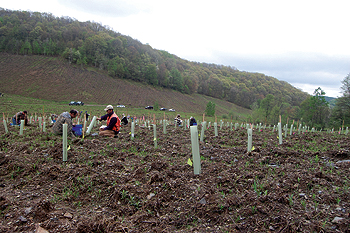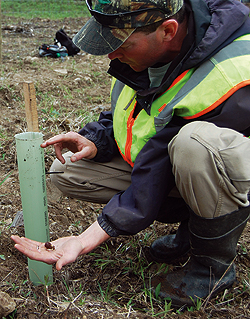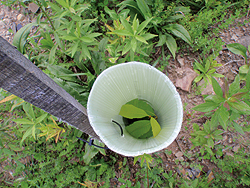Seedling Planting Part Restoration, Part Research

Andy Zadnik, WPC’s land stewardship manager, helps a volunteer place a seedling in a tree tube at the progeny testing site in the Bennett Branch Forest.
Peppering 30 hilly acres in the Western Pennsylvania Conservancy’s Bennett Branch Forest, dozens of volunteers crouched near skinny tree tubes and stooped over metal shovels on a drizzly Saturday. This reclaimed land had been a large stretch of compressed grassland less than six months ago, but workers crosshatched the dirt on the slopes and flatlands. This left a latticework of shallow trenches for workers and volunteers to plant thousands of native hardwood seedlings. By the end of the weekend, the group reached its goal of planting 20,000 mixed hardwoods at the Elk County site.
About an acre of the site was cordoned off with a 6-foot-tall fence designed to keep elk, deer, raccoon and other critters away from an especially valuable batch of small trees. On this spring day, a man in muddy rubber boots, a safety vest-covered windbreaker and a camouflage hat stood in a corner of the enclosure and held a small nut in the palm of his hand. His hand slid up the tree tube to where he had hoped the young trees would grow by mid-summer – about two feet.
This is not only a reforestation project, said Michael French of The American Chestnut Foundation (TACF), but also an investment in the future of a particularly vulnerable species of tree with a tragic history in eastern North America. A fungal disease wiped out billions of American chestnut trees, but foresters like French think they can make a comeback.
“Everything loves to eat chestnuts,” French said as he explained why the acre was fenced off. “We’re working on the blight, but we can’t forget about the animals and everything else that’s out there.”

Michael French, a forester with The American Chestnut Foundation, shows how tall the chestnut seedlings will grow within two months – about two feet.
This planting in May was the last in a number of work days at the Bennett Branch Forest site near Force, Pa., orchestrated by TACF, the Appalachian Regional Reforestation Initiative, Green Forests Work and the Conservancy. While the primary goal of the work is to create a thriving forest on the former strip mine land, the organizers also aimed to create a progeny testing site for a batch of potentially blight-resistant chestnut seedlings.
American chestnuts once heavily populated forests in the eastern United States, standing up to 100 feet tall and numbering in the billions. In 1904, a blight accidentally imported from Asia spread rapidly through the American chestnut population. By 1950 it had killed virtually all the mature trees from Maine to Georgia.
In 1983, a group of scientists formed TACF and began a special breeding process, crossing American and Chinese chestnuts and then repeatedly backcrossing the offspring to American chestnuts. In 2005, the resulting tree, called the Restoration Chestnut 1.0 (genetically 15/16th American and 1/16th Chinese) should have the growth and physical characteristics of American chestnut, with the blight resistance of Chinese. Now assisted by almost 6,000 members and volunteers in 23 states, TACF is undertaking the planting of Restoration Chestnuts in select locations throughout the eastern United States as part of the Foundation’s early restoration efforts.
Planting the hybrids among mixed hardwoods provides real-world testing. Yes, the Restoration Chestnut must fight off blight, but it also must be hardy, standing up to nibbling animals, competitive plants and environmental issues like cold and drought.
Partners, workers and about 80 volunteers from places like Pennsylvania Wildlife Habitat Unlimited and Penn State DuBois planted about 1,000 blight-resistant chestnuts among thousands of other seedlings that have proven to be good, hardy trees at other reclaimed surface mine sites. The plants were a mix of about 18 native species, such as white oak, northern red oak, black locusts and cherry.

Biodegradable tubes protect potentially blight resistant chestnut saplings while they grow.
After the planting, the project partners will enlist local volunteers to monitor trees planted in the fenced-in area. They will be looking for varying levels of blight resistance and growth patterns.
“Hopefully, this will illustrate how chestnuts can compete in a mixed hardwood setting, as well as show how chestnuts and hardwoods can help reclaimed mine sites become thriving forests,” said WPC Land Steward Bryan Ritti.
The Conservancy permanently protected 5,340 acres of scenic hardwood forest in Elk and Clearfield counties in early 2008. The majority of this land was transferred to the Pennsylvania Bureau of Forestry as a permanent addition to Moshannon State Forest. WPC retained a 1,470-acre portion in order to manage the forest resources sustainably and carry out restoration projects. That land is now known as Bennett Branch Forest.
A grant from the U.S. Department of Agriculture Natural Resources Conservation Service provided financial support for the tree planting. Funding from the Richard King Mellon Foundation and the Foundation for Pennsylvania Watersheds supported the land preparation.
Volunteers at the site included Don Schmidt, 68, of Dubois. A member of Pennsylvania Wildlife Habitat Unlimited, Schmidt was eager to help out on a project that could reforest the region’s exceptional natural places.
“I was raised here, so it’s wonderful to see the forest, land and water improve for everyone to enjoy,” Schmidt said.
